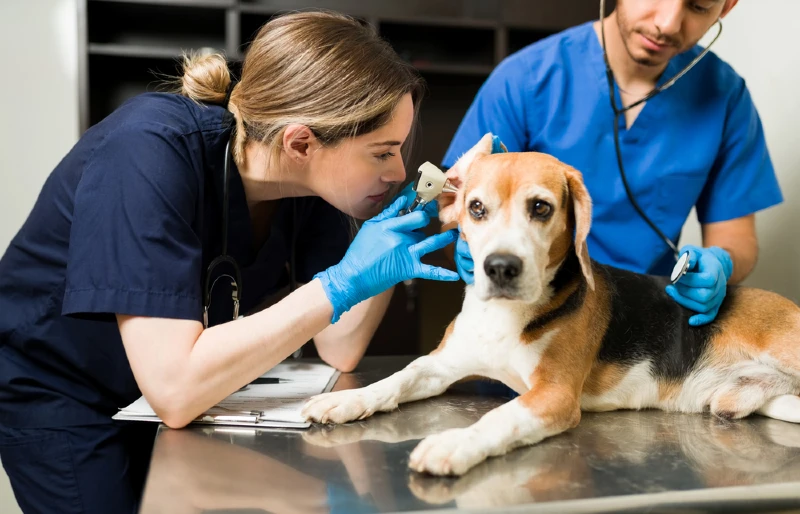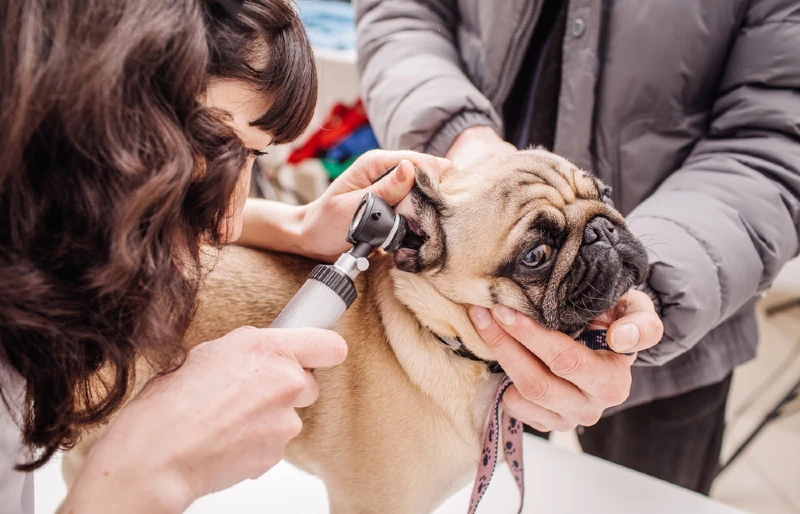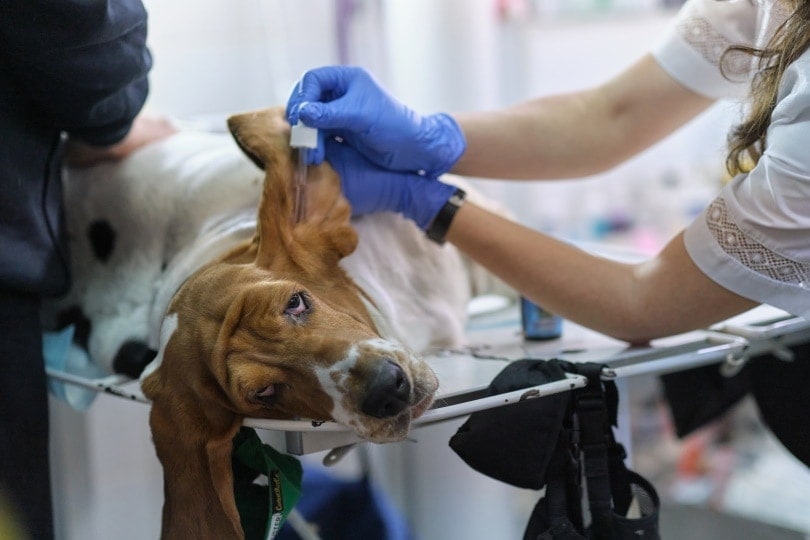32 Dog Breeds Prone to Ear Infections (Plus Signs & Treatment)
By Beth Crane
Updated on

If your dog has an ear infection, you’ll likely notice it pretty quickly. Head shaking, scratching, whining, and generally being miserable are all signs that your pup is suffering from one, but they’re normally fairly easy to treat. However, some breeds are more likely than others to suffer from ear infections.
These are usually breeds that have long or floppy ears that are more likely to trap dirt and moisture inside or breeds that also suffer from skin infections. We brought together 32 of the breeds most prone to ear infections in this list and grouped them by characteristics that could cause more ear infections, so you can see if your dog’s breed is listed and look out for any signs of one occurring!
Click Bellow to Jump to:
- Dogs With Floppy Ears
- Dogs With Hairy Ears and Curly Coats
- Dog Breeds With Narrow Ear Canals or Skin Problems
- Signs of Ear Infections
- Treatments for Ear Infections
Dogs With Floppy Ears

Dogs with long, floppy ears are most likely to suffer from ear infections. Because the ear flaps (or pinna) can cover the ear canal, bacteria and moisture can become trapped inside. The dark, damp, warm environment provides the perfect breeding ground for bacteria and yeast (Malassezia) to grow and multiply.
These two pathogens are the most likely to cause ear infections, and they can proliferate in the environment a floppy ear can create.1 The dogs with longer ears more likely to suffer from ear infections include:
- Basset Hound
- Beagle
- English Cocker Spaniel
- Bloodhound
- English Springer Spaniel
- Coonhound
- Golden Retriever
- Clumber Spaniel
- Cavalier King Charles Spaniel
- Lhasa Apso
- Rottweiler
- Dachshund
- German Shepherd
- Boxer
- Irish Wolfhound
- Irish Setter
Dogs With Hairy Ears and Curly Coats

Dogs with curly or long coats are also more likely to develop ear infections, especially if they also have floppy ears! If a dog’s ear is hairy, it can cause a significant buildup of wax in the ear canal. This wax is the perfect sticking point for bacteria, often clumping together and making the environment excellent for bacterial growth and infection.
Ear hair is supposed to keep wax and debris out of the ears (and it sometimes does). But, if a dog’s ears are too hairy, it can have the opposite effect. Dogs with hairy ears have even more of an issue, as the curls hold more wax! Dog breeds with hairy, curly ears that are more prone to infections include:
- Saluki
- Labradoodle
- Poodle
- Old English Sheepdog
- Bichon Frise
- Shih Tzu
- Lhasa Apso
- Cavapoo
- Airedale Terrier
Dog Breeds With Narrow Ear Canals or Skin Problems

Some breeds have narrower ear canals than others by nature. Several brachycephalic breeds (flat-faced) have this problem, notably the Chinese Shar Pei and the British Bulldog. A narrow ear canal is the perfect collection point for ear wax and bacteria, leading to a build-up of both and a potential ear infection.
Another problem these dogs face is the inability of vets to get an otoscope (a tool used to look into the ears) down the ear canal if the canal is too narrow. Dogs with a propensity for skin problems or allergies are also more likely to suffer from ear irritation and infections. For example, dogs with narrow ear canals and a propensity for allergies include:
- Chinese Shar Pei
- British Bulldog
- Pitbull Terriers
- West Highland White Terriers
- Staffordshire Bull Terriers
- Chow Chows
- Pugs
 Are There Some Breeds Less Likely to Suffer From Ear Infections?
Are There Some Breeds Less Likely to Suffer From Ear Infections?
According to research by the Royal Veterinary College (RVC) of London, England, some breeds are less likely to suffer from ear infections. For example, Chihuahuas, Border Collies, Jack Russell Terriers, and Yorkshire Terriers are all less likely to suffer from ear infections, potentially due to their comparatively large ears.

What Are the Signs of Ear Infections in Dogs?
Ear infections in dogs can present several signs. Dogs can display physical and behavioral signs of ear infections, so look out for any behavioral changes and visual indicators. If you notice any of the following signs of ear infection in your dog, take them to their veterinarian:
- Head shaking
- Scratching at the ears
- Redness inside the ear
- Swelling of the inner ear
- A foul smell
- Brown, yellow, green, or bloody ear discharge
- Pain
What Are the Treatments for Ear Infections for Dogs?
Treatment of your dog’s ear infection will depend on what’s causing it. Several types of bacteria can cause ear infections in dogs, alongside yeast, fungus, and ear mites. Sometimes, foreign bodies cause ear infections, such as grass seeds.
Your veterinarian will look into your dog’s ear to see what could be causing the infection, often after cleaning it with a mild ear cleanser. Treatments can include anti-inflammatory or antibacterial ear drops. If a foreign body is present, the vet will try to remove it. This often needs to be done under anesthesia.

Can I Prevent My Dog’s Ear Infections?
Keeping your dog’s ears clean is the best way to prevent ear infections. Bacteria will almost certainly develop if a dog’s ears are moist and dirty. Ensuring your dog’s ears are dry after every bath and cleaning them regularly is the best way to keep infections at bay.
When cleaning your dog’s ears, try to use a cleaner approved by your veterinarian and follow the instructions. Ensure not to put anything into your dog’s ears before consulting with your vet, and don’t ever use Q-tips to clean their ears. Putting Q-tips down your dog’s ears can cause damage and lots of pain, so only clean the outer area (the pinna) and go no deeper than the first knuckle of your finger.
Take your pup to the vet if you notice any signs of ear infection as soon as possible, as they are irritating and often painful.
Conclusion
Many breeds are more likely than others to suffer from ear infections, and they’re all more likely due to physical traits. For example, dogs with long ears covering their ear canals, dogs with long or curly hair, and dogs with smaller ear canals or skin allergies are more likely to get ear infections. On the opposite end of the doggy scale, Chihuahuas, Jack Russel Terriers, Yorkshire Terriers, and Border Collies are all less likely to suffer from ear infections, likely due to the shape of their ears.
See also:
- Warlock Doberman: Pictures, Info, Temperament & Traits
- Do Dobermans Like Water? Vet-Approved Facts & Safety Tips
Featured Image Credit: Nestor Rizhniak, Shutterstock













